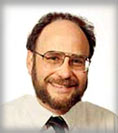 Fred L. Bookstein, Ph.D. Co-investigator, UMVHP Fred L. Bookstein, Ph.D. Co-investigator, UMVHP |
|
| Fred L. Bookstein, biometer, statistical scientist and applied mathematician, is the principal creator of morphometrics, a new specialty that combines techniques of geometry, computer science, and mathematical biology with multivariate statistics in tools for analysis of biological shape variation and shape difference. His innovations are being applied broadly today across evolutionary and developmental biology, paleontology, computer vision, medical imaging, and cognitive neuroimaging. Since 1977 he has produced some 300 books, chapters, articles, and videotapes on various aspects of these methods and their applications in studies of normal and abnormal craniofacial growth in humans and other mammals, studies in the neuroanatomy of schizophrenia and fetal alcohol spectrum disorders, and evolutionary studies of hominids and other paleontological taxa. With his collaborator William D. K. Green, he has developed two public software packages, Edgewarp and Edgewarp3D, that embed the image-related aspects of all these techniques in a convenient common framework for Unix workstations. Beginning in 1999, with major new funding from the National Library of Medicine, a collaboration between the University of Michigan and the Pittsburgh Supercomputing Center is proceeding to embed Edgewarp at the core of a software system for navigation that will supply general public access to extensions of the NLM's visible humans, Adam and Eve, for educational use from high school through medical school. Bookstein is developing a new visual language that extends currently familiar notions of "flyovers'' and "fly-throughs'' for use with these enormous solid data resources and that will merge the spline-based deformation techniques with surface representations for extension to additional specimens and to images from living material. Bookstein's teaching is in morphometrics and in modern philosophy and sociology of quantitative science. |
|


